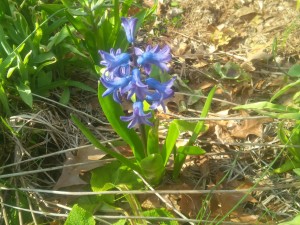
Every year the Pantone Color Institute introduces its “Color of the Year”, reflecting what the Institute thinks is the zeitgeist or prevailing mood for a particular 365-day period. The 2020 color is “Classic Blue”, a shade lighter than navy blue, but deeper than sky blue. On the large Pantone color chart, it is number 19-4052.
Pantone’s Executive Director gets downright poetic when she describes this year’s blue hue:
“We are living in a time that requires trust and faith. It is this kind of constancy and confidence that is inspired by 19-4052, Classic Blue, a solid and dependable blue hue we can always rely on. Imbued with a deep resonance, Classic Blue provides an anchoring foundation. A boundless blue, evocative of the vast and infinite evening sky, Classic Blue encourages us to look beyond the obvious, to expand our thinking; challenging us to think more deeply, increase our perspective and open the flow of communication.”
I am not sure that one color can do all that, but I do know that every garden can probably use a little more blue. Depending on the shade, blue can work well in a number of settings. Pale blues combine perfectly with other pastels in a cottage-type layout. People who love “white” gardens, composed predominately of white, silver, gray and cream-colored flowers and foliage, appreciate the power of blue as an accent color. Blue-leaved hostas add interest to shady places.
I am especially partial to combining shades of blue and yellow, and someday I am going to devote an entire bed or border to that color scheme.
In the meantime, I am thinking of blue plants to add to the spring garden. The following are some possibilities.
Tradescantia: Tradescantia or spiderwort grows like a weed in my garden, popping up and thriving just about everywhere. It is especially effective in partial shade. Most spiderwort flowers are more purple than blue, but some varieties veer strongly towards the blue side. ‘Blue and Gold’ is billed as one of those and it has the added attraction of golden-green foliage, which is a great contrast and all-around garden brightener.
Nigella: English cooking guru, Nigella Lawson, was named after her father, Nigel, but she shares her first name with a lovely annual, Nigella damascena. A member of the buttercup family, nigella is sometimes known as “love-in-a-mist”. The flowers, which sit like stars atop the stalks, can be white, or shades of pink or purple, but my favorite nigella color is sky blue. The leaves are delicate and ethereal—almost lacey—and even the seedheads are pretty enough to include in dried arrangements. Best of all, you can grow nigella from seed in any sunny space. In succeeding years it will self-seed. If you don’t like the other flower colors, you can always grub them out and go with blue alone.
Caryopteris: Blue mist shrub or bluebeard, as caryopteris is known, shines at the end of summer when other flowers are beginning to flag. It is a compact deciduous shrub that rarely grows larger than two feet tall and wide. The flowerheads, composed of myriad tiny individual flowers, look like puffs of blue mist, and attract butterflies. One whiff of the green or green-and-white variegated foliage tells you that caryopteris is a member of the enormous mint or Lamiaceae family. Most of the commercially-available blue mist shrubs are varieties of Caryopteris x clandonensis. ‘Longwood Blue’ boasts medium blue flowers, while ‘Dark Knight’ bears puffs of darker, blue-purple blooms. Blue mist shrub is so good that it deserves wider garden use.
Morning Glory: Blue morning glories or Ipoemea, are so simple and beautiful that people sometimes overlook them. But if you have ever seen a trellis covered with ‘Heavenly Blue” blossoms in high summer, you know how effective these blue wonders are. I bought one package of morning glory seeds about fifteen years ago to grow up the trellising that surrounds the supports for my back porch. I have never had to plant them since, because they have self-seeded quite thoroughly every year. When you are ready to plant your morning glories, soak the fat seeds for eight hours beforehand. This loosens the tough seed coverings and speeds germination. After that, just sit back and wait for heavenly blue to transport you with its blue trumpets.
Delphiniums: I wish I could grow perennial delphiniums, but they really dislike the hot sticky summers in my area. Still, they are so beautiful, with their ramrod straight stalks of lighter or darker blue flowers, that it is almost worth it to grow them as annuals. They do, of course, come in white or pink as well, and plants in those colors mix perfectly with their blue siblings, but for my money, blue delphiniums make some of the best vertical accents in the garden. If you are afraid of plants that need staking, have no fear. Modern compact varieties can often hold themselves up with no help from the gardener. Plenty of water, sunshine and regular fertilization will give your delphiniums the best chance at summer glory and even, possibly, a return engagement the following year.
And if all else blue fails, I can’t think of a better summer scene than a garden full of ‘Nikko Blue’ hydrangeas in full bloom. The sturdy blue globes, redolent of both New England beaches and lazy southern summers, will chase away any psychic blues that might be cluttering your mind.
